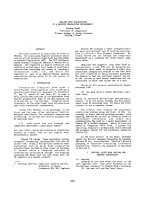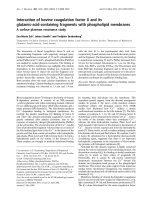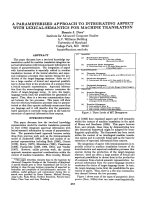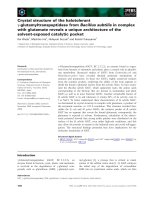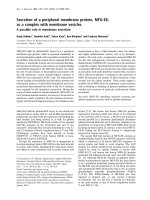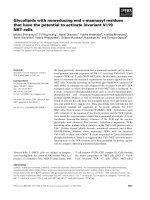Job shop scheduling with makespan objective: A heuristic approach
Bạn đang xem bản rút gọn của tài liệu. Xem và tải ngay bản đầy đủ của tài liệu tại đây (262.49 KB, 8 trang )
International Journal of Industrial Engineering Computations 5 (2014) 273–280
Contents lists available at GrowingScience
International Journal of Industrial Engineering Computations
homepage: www.GrowingScience.com/ijiec
Job shop scheduling with makespan objective: A heuristic approach
Mohsen Ziaee*
Department of Industrial Engineering, University of Bojnord, 94531-55111 Bojnord, Iran
CHRONICLE
ABSTRACT
Article history:
Received July 2 2013
Received in revised format
September 7 2013
Accepted November 23 2013
Available online
November 22 2013
Keywords:
Scheduling
Job shop
Makespan
Heuristic
Job shop has been considered as one of the most challenging scheduling problems and there are
literally tremendous efforts on reducing the complexity of solution procedure for solving job shop
problem. This paper presents a heuristic method to minimize makespan for different jobs in a job
shop scheduling. The proposed model is based on a constructive procedure to obtain good quality
schedules, very quickly. The performance of the proposed model of this paper is examined on
standard benchmarks from the literature in order to evaluate its performance. Computational
results show that, despite its simplicity, the proposed heuristic is computationally efficient and
practical approach for the problem.
© 2014 Growing Science Ltd. All rights reserved
1. Introduction
The job shop scheduling problem (JSP) is one of the most popular scheduling problems in the world
(Jain & Meeran, 1998). It has attracted many researchers due to its wide applicability and inherent
difficulty (Carlier & Pinson, 1989; Kolonko, 1999; Nowicki & Smutnicki, 1996; Yamada & Nakano,
1996; Ho et al., 2007). In the n×m classical JSP, set of n jobs must be processed on a group of m
machines, where the processing of each job i consists of Ji operations performed on these machines.
Each job has a pre-specified processing order on the machines, which is fixed and known in advance,
i.e., each operation needs to be executed on a given machine. Moreover, the processing times of all
operations are also fixed and known in advance. Each machine is continuously available from time zero
and can process at most one operation at a time. The operations are processed on all machines without
interruption (Baker, 1974; Pinedo, 2002). A common objective function is to minimize the makespan,
which is the time needed to complete all the jobs.
In this paper, we present a heuristic method based on a constructive procedure to solve the JSP with the
objective of minimizing makespan (section 3). The primary objective is to produce reasonable and
applicable schedules, very quickly. It can also be used to improve the quality of the initial feasible
* Corresponding author. Tel.: +98 584 2284611; fax: +98 584 2410700
E-mail: (M. Ziaee)
© 2014 Growing Science Ltd. All rights reserved.
doi: 10.5267/j.ijiec.2013.11.004
274
solution of metaheuristics applied to solve the problem, since the choice of a good initial solution is an
important aspect of the performance of the algorithms in terms of computation time and solution
quality (Dell'Amico & Trubian, 1993; Matsuo et al., 1988; Van Laarhoven et al., 1992). In order to
evaluate the performance of the proposed heuristic, The proposed mode has examined on several wellknown benchmarks and the results of the computational experiments are presented (section 4). The
results show that our novel method can obtain good solutions in very short time. Concluding remarks
are given in the last section.
Other assumptions considered in this paper are as follows:
(1) Jobs are independent of each other.
(2) Machines are independent of each other.
(3) Setup and transportation times are negligible.
(4) All jobs have equal priorities.
(5) All jobs are available at time zero.
The notations used throughout the paper are as follows:
n: number of jobs,
m: number of machines,
i,z: index of jobs; i,z=1,…,n,
j: index of operations; j=1,…, m,
k,y: index of machines; k,y=1,…,m,
tij: processing time of operation j of job i,
t′iy: processing time of job i on machine y, that is the processing time of an operation of job i
which is processed on machine y,
cij: completion time of operation j of job i.
2. Literature review
The JSP has been proven to be NP-hard (Garey et al., 1976). Therefore, only small size instances of the
JSP can be solved optimally with good computational time using exact solution methods (Carlier &
Pinson, 1989; Lenstra, 1976). When the problem size increases, the computational time of exact
algorithms grows exponentially. Heuristic algorithms have generally acceptable time and memory
requirements to obtain a near-optimal or optimal solution. During the past few decades, most
researches on the JSP have been concentrated on developing heuristic algorithms (Jain & Meeran,
1998; Blazewicz et al., 1996; Vaessens et al., 1996).
Balas and Vazacopoulos (1998) developed a guided local search algorithm rooted in a specialized
neighborhood tree for the JSP, which is considered as one of the most efficient neighborhood structures
and algorithms for this problem. Pezzella and Merelli (2000) presented a heuristic algorithm based on a
combination of tabu search (TS) method and shifting bottleneck (SB) procedure to solve the JSP. The
SB was used to generate a good initial feasible solution, and a local re-optimization, based on the same
procedure, was used to improve each current solution determined by the TS. Huang and Liao (2008)
presented a hybrid approach combining ant colony optimization (ACO) algorithm with a TS algorithm
to solve the JSP. In this hybrid algorithm, ACO was used to provide an appropriate initial schedule, and
TS was applied to improve the solution quality. The proposed ACO algorithm employed a new
decomposition method inspired by the SB procedure, and a mechanism of occasional re-optimizations
of partial schedules.
275
M. Ziaee / International Journal of Industrial Engineering Computations 5 (2014)
Zhang et al. (2008) presented a hybrid TS-SA algorithm in which simulated annealing (SA) was used to
find the promising elite solutions inside big valley (BV) and TS intensified search around these
solutions. This hybridization can reduce the influence of the initial solution in the TS algorithm. Rego
and Duarte (2009) presented a heuristic algorithm based on a filter-and-fan (F&F) procedure for the
JSP, which uses the SB procedure as a constructive method to generate a starting solution and to
enhance the best schedules produced and a dynamic and adaptive neighborhood search procedure. The
F&F approach is a local search procedure that generates compound moves by an abbreviated form of
tree search. Fıglalı et al. (2009) conducted a statistical experiment on the JSP. They presented an ACObased software system to solve the problem and the parameters of this system were investigated on
various sizes and randomly generated job shop scheduling problems by using design of experiments.
The effects and interactions of the parameters were interpreted with the outputs of the experiments.
Luh and Chueh (2009) presented a multi-modal immune algorithm to solve the JSP emulating the
features of a biological immune system. Operation-based antibody/schedule representation was adopted
to guarantee feasible schedules. The exploration and exploitation of solutions within a search space
were realized through the procedures, which resemble antibody molecule structure, antibody–antigen
relationships in terms of specificity, clonal proliferation, germinal center, and the memory
characteristics of adaptive immune responses.
Lin et al. (2010) presented a hybrid algorithm called MPSO consisting of particle swarm optimization
(PSO), a multiple-type individual enhancement (MIE) scheme based on SA technique, and random-key
(RK) encoding scheme for solving the JSP. The MPSO adopts continuous space as the search space
called RK space and uses the RK encoding scheme to transform a position in RK continuous space to a
discrete space, since the search space in the JSP is a discrete space. In RK space, a position of a particle
composed of n×m real numbers can represent the permutation of all operations of all jobs by the
encoding scheme. Asadzadeh and Zamanifar (2010) proposed an agent-based parallel genetic algorithm
for the JSP. The agent-based parallel approach was used to parallelize the genetic algorithm and to
accelerate the creation of the initial population of genetic algorithm. Some other recent studies on the
problem are: (Gao et al., 2011; Kammer et al., 2011; Lochtefeld & Ciarallo, 2011; Mati et al., 2011;
Sels et al., 2011; Ponsich & Coello, 2013; Zhang et al., 2013).
3. Proposed heuristic approach
In this section, a heuristic method is presented to solve the problem. This approach is motivated by the
idea of developing a constructive heuristic, which considers simultaneously many factors influencing
the solution quality and intelligently balances their effects, in the process of schedule generation, and
the observation that it could lead to good results in some preliminary computational experiments on a
wide range of complicated scheduling problems. This algorithm has a simple structure, is easy to
implement, and requires very little computational effort; which makes it preferable over other more
complex and time-consuming approaches, even if its results for benchmark instances are so weakly
dominated the lower bounds in the literature. Some notations that will be used in the algorithm are
defined as follows:
m
sji: total processing time of job i (i.e.,, sji = tij ),
j 1
n
sk y: total processing time on machine y which is calculated as follows: sky= tiy ,
i 1
M: a large number.
An outline of the proposed heuristic algorithm is given in Fig. 1.
276
until all operations of all jobs are scheduled, repeat
{
Find i, j (such that: 1. j=1 or (j-1)th operation of job i is already scheduled, and 2. jth operation of
job i is unscheduled) that minimizes TC.
Schedule jth operation of job i on the last position of current partial sequence on machine k (the
machine capable of processing operation j of job i).
}
Fig. 1. General outline of the proposed heuristic algorithm
The pseudocode of the proposed heuristic is shown in Fig. 2. In this algorithm, each unscheduled
operation (i, j) (operation j of job i) to be scheduled on machine y is evaluated by the following
criterion, and the unscheduled operation with minimum TC is selected for scheduling.
6
TC = wr .xr .Cr
r 1
such that,
C1 = max (Cmaxy, ci,j-1 )+ tij ,C2 = max (0,( ci,j-1 -Cmaxy)), C3 = max (0,(Cmaxy- ci,j-1 )), C4 = tij
C5 = sky, C6 = sji
TC is weighted sum of some criteria which are established based on the factors affecting the objective
function value. Minimization of TC in the process of schedule generation leads to improvement in
solution quality. wr (r=1,2,…,6) are constants and xr (r=1,2,…,6) are integer variables used to increase
the flexibility and effectiveness of criterion TC and have a significant impact on the performance of the
algorithm. The constant weights (wr) are preliminary estimated weights assigned to criteria according
to their importance, and the coefficients xr are variables bounded in a given range and used to refine the
TC. Cmaxy is the maximum completion time across all the operations scheduled on machine y; that is,
Cmaxy is equal to the completion time of the operation situated just before operation j of job i on
machine y. C1, C2 and C3 are applied to decrease Cmaxy, idle times, and flowtime of jobs, respectively;
clearly, all these three objectives affect the main objective function, i.e. Cmax. For assigning operations
to a machine, their processing time are also taken into account by C4. According to C5, the jobs with
larger sji, are scheduled sooner. C6 is used for taking into account the total processing time of machines.
Other notations used in the pseudocode of the proposed heuristic are as follows:
TC*: denotes the best value of TC. After scheduling each operation, TC* is reset to M.
L_xr (r=1,2,…,6): lower limit of xr.
U_xr (r=1,2,…,6): upper limit of xr.
As it can be seen in the pseudocode of the heuristic, the algorithm first sorts the jobs in decreasing
order of their sji and then uses this order for evaluating their operations. Therefore, if two unscheduled
operations belonging to two different jobs have the same value of TC, then according to this sorting of
the jobs, the operation of job with greater sji is selected for scheduling sooner than the other operation.
This sorting may lead to better solutions. xr*(r=1,2,…,6) are the best values of variables xr (i.e. the
values corresponding to the best solutions). Indeed, for various values of xr (r=1,2,…,6), the algorithm
of Fig. 1 is run and a complete schedule is generated. Among all these schedules, the one with
minimum makespan is reported as the final solution. The values of variables xr for this best solution are
also reported and denoted by xr* (see Table 2). As mentioned earlier, the evaluation of the operations
for scheduling them is done using the criterion TC, i.e. the unscheduled operation with minimum TC is
selected for scheduling.
277
M. Ziaee / International Journal of Industrial Engineering Computations 5 (2014)
Initialization:
Sort the jobs in increasing order of their sji and call the resulting set: i_sort. Let i_sortz be
zth job of the list i_sort.
Constructive Algorithm:
for x1 :=L_x1 to U_x1 do
for x2 :=L_x2 to U_x2 do
for x6 :=L_x6 to U_x6 do
{
% Beginning of a schedule generation
until
{
all operations of all jobs are scheduled, repeat the following steps:
Set TC*:=M
for j:= 1 to m do
{
for i’:=1 to n do
{
Set i:= i_sort(n-i’+1) ,
if (
1. j=1 or (j-1)th operation of job i is already
2. jth operation of job i is unscheduled) then
scheduled, and
{
6
Set TC:=
w r .xr .C r
r1
if TC
Set TC*:= TC
Set z:=i
Set j’:=j
}
}
}
}
if TC*
job z) to finish at time czj’.
}
% End of a schedule generation
If the objective value of the obtained sequence (Cmax ) is less than the best objective value
obtained so far (Cmax*), then set Cmax*:=Cmax and xr* =xr (r=1,2,…, 6) corresponding to Cmax*.
}
Fig. 2. Pseudocode of the proposed heuristic method
4. Computational results
This section describes the computational experiments conducted in order to evaluate the performance
of the proposed heuristic method. First, some preliminary experiments have been conducted for the
parameter settings. Regarding the test on various values for the parameters of the algorithm and
considering the computational results, we use the settings of Table 1 for benchmarking the presented
algorithm.
Table 1
Parameter settings for the heuristic
Parameter
w1
w2
w3
w4
w5
w6
Value
2
2
1
1
1
1
Parameter
L_x1
L_x2
L_x3
L_x4
L_x5
L_x6
Value
1
0
−3
−1
−2
−1
Parameter
U_x1
U_x2
U_x3
U_x4
U_x5
U_x6
Value
4
3
0
0
0
0
278
Table 2
Computational results for benchmark instances
Size
Name
LA01
LA02
LA03
LA04
LA05
LA06
LA07
LA08
LA09
LA10
LA11
LA12
LA13
LA14
LA15
LA16
LA17
LA18
LA19
LA20
LA21
LA22
LA23
LA24
LA25
LA26
LA27
LA28
LA29
LA30
LA31
LA32
FT06
FT10
FT20
ORB01
ORB02
ORB03
ORB04
ORB05
ORB06
ORB07
ORB08
ORB09
Average
Heuristic
n
m
10
10
10
10
10
15
15
15
15
15
20
20
20
20
20
10
10
10
10
10
15
15
15
15
15
20
20
20
20
20
30
30
6
10
20
10
10
10
10
10
10
10
10
10
5
5
5
5
5
5
5
5
5
5
5
5
5
5
5
10
10
10
10
10
10
10
10
10
10
10
10
10
10
10
10
10
6
10
5
10
10
10
10
10
10
10
10
10
BKS
PaGA
RPD
666
655
597
590
593
926
890
863
951
958
1222
1039
1150
1292
1207
945
784
848
842
902
1046
927
1032
935
977
1218
1235
1216
1152
1355
1784
1850
55
930
1165
1059
888
1005
1005
887
1010
397
899
934
666
655
617
607
593
926
890
863
951
958
1222
1039
1150
1292
1207
994
793
860
873
912
1146
1007
1033
1012
1067
1323
1359
1369
1322
1437
1844
1907
55
997
1196
1149
929
1129
1062
936
1060
416
1010
994
0
0
3.35
2.881
0
0
0
0
0
0
0
0
0
0
0
5.185
1.148
1.415
3.682
1.109
9.56
8.63
0.097
8.235
9.212
8.621
10.04
12.58
14.76
6.052
3.363
3.081
0
7.204
2.661
8.499
4.617
12.34
5.672
5.524
4.95
4.786
12.35
6.424
4.273
Cmax
Time(s)
x1
x2
x3
x4
x5
x6
RPD
694
697
640
605
593
926
897
869
951
958
1222
1039
1150
1292
1266
1027
822
871
883
953
1150
999
1077
1023
1108
1312
1378
1350
1348
1473
1844
1881
55
1028
1244
1160
929
1106
1062
977
1102
442
991
1051
0.09
0.09
0.09
0.09
0.00
0.00
0.20
0.20
0.02
0.00
0.02
0.02
0.02
0.00
0.34
0.27
0.27
0.27
0.27
0.27
0.59
0.59
0.61
0.61
0.59
1.03
1.03
1.03
1.02
1.05
2.28
2.30
0.02
0.27
0.34
0.27
0.27
0.28
0.28
0.27
0.27
0.27
0.28
0.28
0.42
1
3
3
3
2
2
1
2
2
1
1
3
1
1
2
4
2
4
3
4
2
3
4
4
2
4
3
3
2
4
1
1
2
3
4
1
2
1
3
3
3
2
3
2
2.432
0
0
1
0
0
0
2
3
0
0
0
0
0
0
3
3
2
2
2
3
2
2
1
2
1
1
0
2
3
2
0
2
0
3
2
0
2
0
3
2
2
1
0
1
1.25
-2
-1
0
-3
-3
-3
0
-1
-3
-3
-3
-3
-3
-3
0
-2
0
0
0
-2
0
-1
-2
-1
-1
-3
-1
-3
-1
-2
-2
-3
-3
0
0
0
0
0
-1
-1
0
-1
0
-3
-1.45
0
0
-1
-1
-1
-1
-1
0
-1
-1
-1
-1
-1
-1
-1
0
-1
-1
-1
-1
0
0
-1
0
-1
-1
-1
-1
0
-1
0
-1
-1
0
0
-1
-1
-1
-1
0
-1
0
-1
0
-0.68
-2
-2
-2
-2
-2
-2
-1
-1
-2
-2
-2
-2
-2
-2
-2
0
0
-2
0
-1
0
-2
-2
-1
-1
-2
-2
-1
-1
-2
0
-1
-1
0
-2
0
-1
-1
0
-1
-2
-1
-2
-2
-1.34
-1
-1
-1
-1
-1
-1
-1
-1
-1
-1
-1
-1
-1
-1
-1
-1
-1
-1
-1
-1
-1
-1
0
-1
-1
-1
-1
-1
-1
-1
0
-1
-1
-1
-1
0
-1
0
-1
-1
0
-1
-1
-1
-0.89
4.204
6.412
7.203
2.542
0
0
0.787
0.695
0
0
0
0
0
0
4.888
8.677
4.847
2.712
4.869
5.654
9.943
7.767
4.36
9.412
13.41
7.718
11.58
11.02
17.01
8.708
3.363
1.676
0
10.54
6.781
9.537
4.617
10.05
5.672
10.15
9.109
11.34
10.23
12.53
5.909
The algorithm is coded in C language and run on a Pentium IV, 2.2 GHz and 2.0 GB RAM PC. Three
sets of benchmark problem instances are considered: 32 instances denoted as (LA01−LA32) presented
by Lawrence (1984), 3 instances (FT6, FT10, FT20) of Fisher and Thompson (1963), and 9 instances
(ORB01−ORB9) of Applegate and Cook (1991). All the instances can be downloaded from ORLibrary web site ( Table 2 shows a comparison of the
makespan results of our algorithm with those of the recently published algorithm: the parallel agentbased genetic algorithm (PaGA) proposed by Asadzadeh and Zamanifar (2010). The first four columns
provide the problem name, its size in terms of the number of jobs (n) and machines (m), and the best
known solution (BKS) for each instance. The results obtained by proposed algorithm are shown in the
last nine columns. Cmax and Time(s) stand for the makespan and the computational time (in seconds),
respectively. The best values of variables xr (i.e. xr*), r=1,2,…,6; are also reported in Table 2. Average
values of x3, x4, x5 and x6 are negative, that means they have adverse effect on Cmax. RPD is the relative
percentage deviation to BKS and calculated as follows:
C max a lg BKS
RPD
100 ,
BKS
where Cmaxalg is the makespan obtained by the algorithm. PaGA and our algorithm have average RPD
279
M. Ziaee / International Journal of Industrial Engineering Computations 5 (2014)
values of 4.27 and 5.91, respectively. Herein, the heuristic is statistically compared with PaGA. A oneway analysis of variance (ANOVA) (Montgomery, 2000) is performed to test the null hypothesis that
the means of the two methods are equal. The results of this ANOVA are presented in Table 3. As can
be seen, the difference between the methods is not meaningful at a significance level of 5%. However,
the heuristic is very fast, and needs less than 0.5 sec. on average for all instances.
Table 3
Results of one-way ANOVA for the methods: PaGA and proposed heuristic
Source
Factor
Error
Total
DF
1
86
87
SS
58.9
1683.9
1742.8
MS
58.9
19.6
F
3.01
P
0.086
5. Conclusion
This paper has investigated the job shop scheduling problem with the objective of minimizing the
makespan. The main purpose was to produce reasonable schedules very quickly. A simple and easily
extendable heuristic based on a constructive procedure has been presented. The algorithm has beed
examined on benchmark instances from the literature in order to evaluate its performance. The
computational results have shown that even the relatively straightforward implementation of the
approach as presented here, could yield good quality solutions with very little computational effort.
Since the proposed method is a heuristic, its results cannot be compared in a meaningful way with
those of the methods evaluated as they are metaheuristic based algorithms. However, the computational
times show the interest of the heuristic, since in a fraction of a second on average, it produces very
good solutions. Although the solutions produced by this simple heuristic are weakly dominated the
solutions of the metaheuristic methods evaluated, the procedure is useful in applications that deal with
real time systems and that involve the generation of initial schedules for local search and metaheuristic
algorithms. Further research needs to be conducted in applying other criteria in the TC in order to
improve the solution quality and to adapt the approach to the flexible job shop scheduling problem.
References
Applegate, D., & Cook, W. (1991). A computational study of the job-shop scheduling problem. ORSA
Journal on Computing, 3(2) 149–156.
Asadzadeh, L., & Zamanifar, K. (2010). An agent-based parallel approach for the job shop scheduling
problem with genetic algorithms. Mathematical and Computer Modelling, 52, 1957–1965.
Baker, K. (1974). Introduction to sequencing and scheduling. NewYork: Wiley.
Balas, E., & Vazacopoulos, A. (1998). Guided local search with shifting bottleneck for job shop
scheduling. Management Science, 44(2), 262–275.
Blazewicz, J., Domschke, W., & Pesch, E. (1996), The job shop scheduling problem: conventional and
new solution techniques. European Journal of Operational Research, 93, 1–33.
Carlier, J., & Pinson, E. (1989). An algorithm for solving the job-shop problem, Management Science,
35, 164–176.
Dell'Amico, M., & Trubian, M. (1993). Applying tabu-search to the job-shop scheduling problem.
Annals of Operations Research, 4, 231–252.
Fıglalı, N., Ozkale, C., Engin, O., & Fıglalı, A. (2009). Investigation of ant system parameter
interactions by using design of experiments for job-shop scheduling problems. Computers &
Industrial Engineering, 56, 538–559.
Fisher, H., & Thompson, G.L. (1963). Probabilistic learning combinations of local job shop scheduling
rules. J.F. Muth, G.L. Thompson (Editors), Industrial Scheduling, Prentice-Hall, Englewood Cliffs,
New Jersey, pp. 225–251.
Gao, L., Zhang, G., Zhang, L., & Li, X. (2011). An efficient memetic algorithm for solving the job
shop scheduling problem. Computers & Industrial Engineering, 60(4), 699–705.
280
Garey, M.R., Johnson, D.S., & Sethi, R. (1976). The complexity of flow shop and job-shop scheduling.
Mathematics of Operations Research, 1(2), 117–129.
Ho, N.B., Tay, J.C., & Lai, E.M.-K. (2007). An effective architecture for learning and evolving flexible
job-shop schedules. European Journal of Operational Research, 179, 316–333.
Huang, K.-L., & Liao, C.-J. (2008). Ant colony optimization combined with taboo search for the job
shop scheduling problem. Computers & Operations Research, 35, 1030–1046.
Jain, A.S., & Meeran, S. (1998). Deterministic job-shop scheduling: Past, present and future. European
Journal of Operational Research, 113(2), 390–434.
Kammer, M., Akker, M., & Hoogeveen, H. (2011). Identifying and exploiting commonalities for the
job-shop scheduling problem. Computers & Operations Research, 38(11), 1556–1561.
Kolonko, M. (1999). Some new results on simulated annealing applied to the job shop scheduling
problem. European Journal of Operational Research, 113, 123–136.
Lawrence, S. (1984). Supplement to Resource constrained project scheduling: An experimental
investigation of heuristic scheduling techniques. Graduate School of Industrial Administration,
Carnegie Mellon University, Pittsburgh, Pennsylvania.
Lenstra, J.K. (1976). Sequencing by enumerative methods. Tech. Rep. Mathematical Centre Tract 69,
Mathematisch Centrum, Amsterdam.
Lin, T.-L., Horng, S.-J., Kao, T.-W., Chen, Y.-H., Run, R.-S., Chen, R.-J., Lai, J.-L., & Kuo, I-H.
(2010). An efficient job-shop scheduling algorithm based on particle swarm optimization. Expert
Systems with Applications, 37, 2629–2636.
Lochtefeld, D.F., & Ciarallo, F.W. (2011). Helper-objective optimization strategies for the Job-Shop
Scheduling Problem. Applied Soft Computing, 11(6), 4161–4174.
Luh, G.-C., & Chueh, C.-H. (2009). A multi-modal immune algorithm for the job-shop scheduling
problem. Information Sciences, 179, 1516–1532.
Mati, Y., Dauzère-Pérès, S., & Lahlou, C. (2011), A general approach for optimizing regular criteria in
the job-shop scheduling problem. European Journal of Operational Research, 212(1), 33–42.
Matsuo, H., Suh, C., & Sullivan, R. (1988). A controlled search simulated annealing method for the
general job-shop scheduling problem, Tech. Rep. 03-04-88, Dept. of Management, The University of
Texas, Austin.
Montgomery, D.C. (2000). Design and analysis of experiments. 5th ed., NewYork: John Wiley & Sons.
Nowicki, E., & Smutnicki, C. (1996). A fast tabu search algorithm for the job shop problem.
Management Science, 42(6), 797–813.
Pezzella, F., & Merelli, E. (2000). A tabu search method guided by shifting bottleneck for the job shop
scheduling problem. European Journal of Operational Research, 120, 297–310.
Pinedo, M. (2002). Scheduling: theory, algorithms and systems. Englewood cliffs, NJ: Prentice-Hall.
Ponsich, A., & Coello, C.A.C. (2013). A hybrid Differential Evolution—Tabu Search algorithm for the
solution of Job-Shop Scheduling Problems. Applied Soft Computing, 13, 462–474.
Rego, C., & Duarte, R. (2009). A filter-and-fan approach to the job shop scheduling problem.
European Journal of Operational Research, 194, 650–662.
Sels, V., Craeymeersch, K., & Vanhoucke, M. (2011), A hybrid single and dual population search
procedure for the job shop scheduling problem. European Journal of Operational Research, 215 (3)
512–523.
Vaessens, R.J.M., Aarts, E.H.L., & Lenstra, J.K. (1996), Job shop scheduling by local search.
INFORMS Journal on Computing, 8(3) 302–317.
Van Laarhoven, P., Aarts E., & Lenstra J. (1992). Job shop scheduling by simulated annealing.
Operations Research, 40, 113–125.
Yamada, T., & Nakano, R. (1996), A fusion of crossover and local search, in: Proceedings of the IEEE
International Conference on Industrial Technology ICIT96, Shangai, China, IEEE Press 426–430.
Zhang, C.Y., Li, P.G., Rao, Y.Q., & Guan Z.L. (2008), A very fast TS/SA algorithm for the job shop
scheduling problem. Computers & Operations Research, 35, 282–294.
Zhang, R., Song, S., & Wu, C. (2013). A hybrid artificial bee colony algorithm for the job shop
scheduling problem. International Journal of Production Economics, 141, 167–178.


